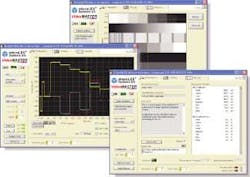Virtual instruments take aim at video analysis
Before shipping their set-top boxes, game consoles, and cameras, OEMs need to test the video output of such devices to ensure that they comply with international broadcast standards. Using waveform analyzers for assessing their test systems, manufacturers can capture pertinent information about such video signals and whether a particular piece of equipment complies with those standards. Hence, analyzing the waveform display of composite, S-video, and HDTV signals, test engineers can measure amplitude and time parameters of the video waveform and provide quality-control feedback to the manufacturing process.
In the past, this market was dominated by well-known US companies including Leader Instruments (Cypress, CA; www.leader usa.com), Tektronix (Wilsonville, OR; www.tek.com), and Videotek (Pottstown, PA; www.videotek.com). These companies offer stand-alone test equipment to meet the needs of the broadcast video market (see Vision Systems Design, Sept. 1998, p. 78).
Today, the advent of low-cost PCs and PC-based digitizers means that many video test systems can be built using off-the-shelf hardware. “About a year ago,” says Birger Schneider, managing director of microLEX Systems (Hoersholm, Denmark; www.microlexsys.com), “our company was approached by National Instruments (NI; Austin, TX, USA; www.ni.com) to develop such equipment based around the PCXI standard.” According to Schneider, NI identified this as a target market and encouraged microLEX to develop a series of low-cost video-analysis products.
The company’s first product, the Videomaster composite and S-video analyzer, is designed to measure analog PAL, NTSC in composite video, and S-video formats. The analyzer consists of two boards: NI’s 14-bit, 100-MSample/s PXI-5122 digitizer and a PXI-8175 embedded controller with 256 Mbytes of memory. Alternatively, a PC can be used with just a PCI-5122 digitizer board.
With a software tool suite of LabVIEW virtual instruments (VIs), the device can perform acquisition, analysis, and file I/O operations. A graphical user interface built with LabVIEW interactively views and analyzes video signals, performs editing measurement locations, and sets up automated testing procedures. According to Schneider, the software can also perform off-line analysis of stored video signal files, even when no test hardware is available.
For use in a production environment, the video analyzer offers an auto test wizard user interface that allows the user to configure and run an entire set of measurements at the touch of a button, or by a single call in LabVIEW. The system can then generate a full test report that includes color-bar analysis, horizontal timing, vertical blanking, and jitter-error measurements.
To integrate the Videomaster into traditional test sequencers such as NI TestStand or a proprietary LabVIEW-based test sequencer, microLEX offers systems developers a StepType auto test wizard. Alternatively, a user can integrate Videomaster application programming interfaces (APIs) into proprietary software. To use Videomaster APIs requires the installation of the LabVIEW 7.0 development system and NI’s Scope 2.5 driver. Alternatively, Videomaster C-APIs can be used with C-based applications.
“Because composite video, also referred to as CVBS (color, video, blanking, and sync), differs around the world according to the combination of various color encoding and transmission standards,” says Schneider, “we have developed custom software for the system that allows PAL-B/D/G/H/I, NTSC-M, PAL-M, NTSC-4.43, and PAL-N formats to be analyzed.” These systems use the standard definition aspect ratio of 4:3, a scanning sequence from left to right and from top to bottom, and an interlace ratio of 2:1, resulting in a picture (frame) frequency of half the field frequency. S-video signals with separate luminance and chrominance channels can also be acquired and analyzed by the system.
Baxall (Stockport, UK; www.baxall.com), a manufacturer of CCTV equipment and video network solutions, has already deployed the Videomaster in a CCTV video-camera production line. “Unlike some traditional video analyzers and production test equipment, the 14-bit resolution and 100 MSample/s of the PXI-5122 digitizer, or 200 Msample/s at 12 bit of the PXI-5124, allow us to perform the same test with fewer video line averages and make the system between eight and 16 times faster,” Schneider claims.
Recently, microLex introduced its SuperVision, an NI-enabled system that consists of a PC, an inspection chamber, and a fixed-position color camera. Running NI’s IMAQ vision, the PC controls the setup and test execution of PCB inspection applications. “Using open hardware standard instruments allows us to improve system performance by using value added software,” says Schneider.

